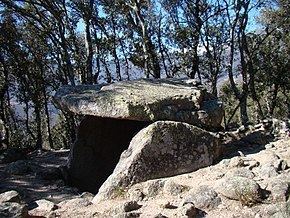Length 3 m Height 1.5 m | Type Dolmen Width 2 m | |
 | ||
The Caixa de Rotllan (meaning "Roland's Tomb" in Catalan language) is a dolmen in Arles-sur-Tech, Pyrénées-Orientales, South of France, dating back to the Neolithic period, during the second half of 3rd millennium BC.
Contents
A legend holds that Roland lived in Vallespir and that, after his death at the Battle of Roncevaux Pass, his horse Veillantif carried Roland's corpse back to Vallespir and buried him under this dolmen. Dolmens are actually tombs, but they were erected many centuries before the legendary knight's adventures.
The Caixa de Rotllan is made of three upright stones making a H-shape, supporting a thick roofing stone and delimiting a rectangular, medium-sized chamber. The entrance faces South-East, as many other dolmens do in Pyrénées-Orientales. This building is listed as a Monument historique since 1889 but has never been excavated by archaeologists.
Location
The Caixa de Rotllan is one of the 148 dolmens listed in the Pyrénées-Orientales department. Some of them have been destroyed or attested by old sources but lost and not yet found by modern scholars. They are all located in hilly or mountainous areas of the department, usually on a mountain pass, a ridge or a high ground.
As the others, this dolmen is situated on a ridge line. In the southern side of the Canigou, at 830 metres (2,720 ft) above sea level, just beneath a granitic chaos in the historical and geographical region named Vallespir it stands on the edge between French communes Arles-sur-Tech and Montbolo.
Two ways lead to the dolmen from Arles town. A passable track along the Bonabosc river leads near it, but one must leave this track to have a 60 metres (66 yd) walk to reach the dolmen. The GR 10 footpath also runs near the dolmen. This part of the GR 10 is an old busy track people used to tread to reach iron ore mines from Arles-sur-Tech. This way is an hour and a half's walk.
On 1:25000 map by Institut Géographique National, the Caixa de Rotllan is indicated by a star, as a curiosité (French word for "curiosity").
Description
Like most of dolmens in the Pyrénées-Orientales, the Caixa de Rotllan has a simple plan — that is, without corridor —, which relates it to other dolmens from chalcolithic and Bronze age, during the second half of the third millennium BC.
Toponymy and Legend
In Catalan language Caixa de Rotllan means « Roland's grave » and shows that the inhabitants of the region knew for long that the dolmen had been used as a grave. Many megaliths in the Pyrénées-Orientales are named after mythic characters such as Roland or his enemies the "Moors" (Catalan: Moros). Some other very near places are named after Roland.
1,500 metres (4,900 ft) north from the Caixa along the ridge line lies the Palet de Rotllan ("Roland's Puck"). It refers to an ancient game named Palet, in which players had to knock down a target (usually a stick) standing on the ground throwing a puck (or Palet) to it. According to a legend, Roland played this game, but used huge stones intstead of pucks and enjoyed aiming at castles of Vallespir as targets.
Further to the north, lies the abeurador del cavall de Rotllan ("the Watering trough of Roland's Horse") where the legedary knight's horse Veillantif used to drink. The Cova d'en Rotllan ("Roland's cave") is another dolmen situated in Corsavy, a nearby commune where Roland used to rest.
According to The Song of Roland, Roland and his friends Oliver and Turpin died at the Battle of Roncevaux Pass and their corpses were brought to and buried in the Basilica of St. Romain, in Blaye, by Charlemagne. Another legend tells that Veillantif, Roland's horse, brought the corpse of his master to the Vallespir near the place where he used to play palet. A tomb was built there: it is the Caixa de Rotllan. Many places in this region are named after the pawprints left by Veillantif.
History
The Caixa de Rotllan may have been erected during the Chalcolithic or the beginning of the Bronze Age, during the second half of the 3rd millennium BC.
During the Middle Ages it marked the boundary between Arles and Montbolo. The current boundary between these two communes runs very near the dolmen.
The first paper that mentioned this dolmen was an article written by Jean-Baptiste Renard de Saint-Malo in 1837 and entitled « Monument druidique (entre Arles et Batère) » (Druidic monument between Arles and Batere). But Renard de Saint-Malo made a confusion between the Caixa and another stone, the palet of Roland, very near. Louis Companyo's Histoire naturelle du département des Pyrénées-Orientales (Natural History of the Pyrénées-Orientales Département), in 1861, corrected this mistake, said that the palet is not a dolmen and warned its readers against the frequent confusion between some natural stones and dolmens. · The first scientific description of the Caixa was made by Alexandre-Félix Ratheau in 1866, in « Note sur un monument celtique du département » (Note On A Celtic Monument Of The Département) published in the Bulletin de la Société agricole, scientifique et littéraire des Pyrénées-Orientales. At this time, people thought that dolmen have been built by the Celts. In his paper, Ratheau, a French engineer, author of several books on fortications, wrote the dolmen's dimensions, its orientation relative to the North and a plan with three elevation cuts. Ratheau said that the palet was made of pieces of abandoned granit grindstones and clarified Companyo's correction. Indeed, reading Companyo's paper, people may have think that no Caixa de Rotllan dolmen existed. In 1887, an engraving, made from a photograph, of the dolmen was published in La création de l'Homme et premiers âges, by Henri Raison du Cleuziou. In 1889, the Caixa de Rotllan was classified as a Monument historique.
